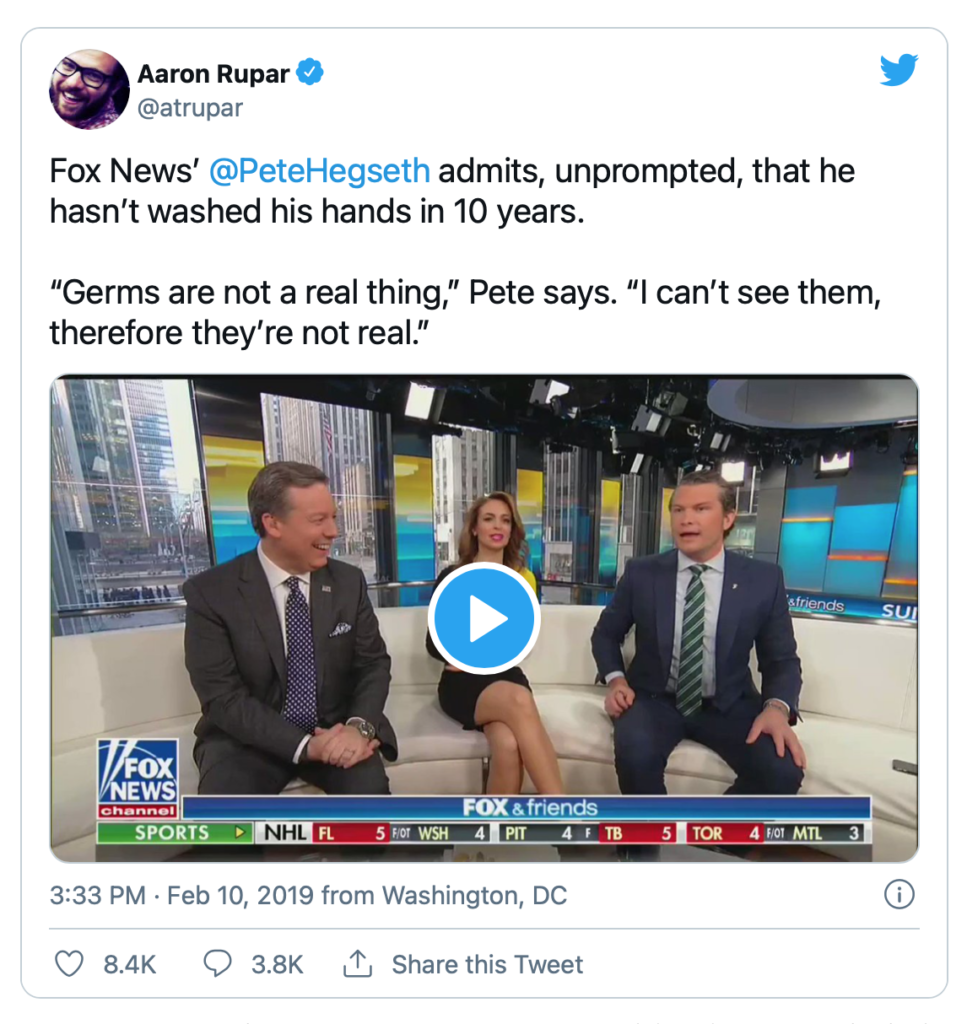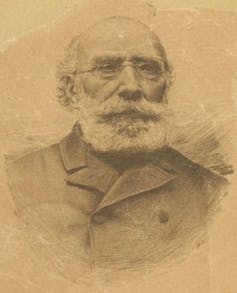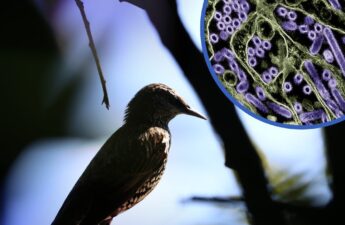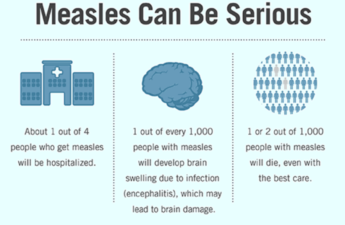Caitjan Gainty, King’s College London
Back in February 2019, when the pandemic was still far from most people thoughts, the Fox News programme Fox & Friends aired a segment in which contributor Pete Hegseth revealed he had not washed his hands in ten years. Far from being appalled, the show’s hosts burst out laughing.

As it turns out, Hegseth’s poor hand hygiene was not so novel. According to the World Health Organization, only 19% of the pre-COVID world washed their hands after using the toilet. The reasons for this ranged widely, from a basic lack of clean water to forces like peer pressure or overinflated optimism about one’s health. But that wasn’t Hegseth’s reason. He said his decade of hand-washing abstinence was based on his belief that germs did not exist. If he could not see them, he explained, they were not real.
Even pre-pandemic, a pronouncement like this sounded alarm bells. Whether Hegseth realised it or not, and whether he was serious or not, he was reciting the creed of germ theory deniers, a mixed group whose beliefs range from hardline renunciation of germ theory – in which the very notion that germs exist is denied – and the softer disavowal of the significance of germs to explain disease.
In the late 19th century, Louis Pasteur, Robert Koch, Joseph Lister and others established that disease was caused by living organisms that invade the body. But the theories that Pasteur and the others promulgated were not yet very nuanced or completely coherent. Indeed, as historians have pointed out, it is more appropriate to speak of the “germ theories” of the late 19th century, and to some degree the early 20th. There was still much to work out. For example, if only some people got sick when exposed to a specific pathogen, didn’t that mean that germ theory only held in some cases?
It was also unclear in these early years how the theory might be useful. Its predecessor in disease causation, miasma theory, which traced disease to “bad air”, had spurred sanitation movements that had vastly improved public health. The resulting reduction in disease did not necessarily validate miasma theory, but it made it clear that, whatever its theoretical shortcomings, it held practical power. Germ theory couldn’t immediately say the same. It is in the uncertainties of this early, confusing environment that germ theory denialists situate their claims.
Bitter crank
Though historians have drawn out the nuances of how scientific knowledge was created and contested in the late 19th century, denialists have been more interested in locating the path not taken – or, as they see it, covered up. They have found this in the work of Antoine Béchamp, a chemist, Pasteur contemporary, and by some accounts “bitter crank”, whose theories concerning disease focused on the state of the host rather than microbes themselves.
One much-referenced text about Béchamp is a 1920 book that tells his story as a “lost chapter in the history of biology”. It describes his notion that microbes were not the malicious invaders that germ theorists claim (why else would they not cause disease always and everywhere?). Instead he thought illness essentially depended on “tiny molecular granulations” called microzymas, which only become pathogenic when a change in environmental balance or function made them so. It was from this change in the bodily “terrain”, and not from germ invasion, that illness arose.

Many germ theory deniers are adherents to this terrain theory, extrapolating from Béchamp a variety of alternative therapies specifically tailored to reduce toxins and rebalance the body. The therapies promise to create a corporal environment rendered immune (though they would not use this term) to microbes because it lives peaceably with them.
This is an idea that inflames many of those who police the lines of medical and scientific orthodoxy. Yet, as diametrically opposed adherents to germ theory and Béchamp’s terrain theory seem, the two ideas have not always been considered mutually exclusive.
Over the mid-20th century, the prominent immunologist Thomas Magill gave voice to a growing concern in his field when he pondered the idea that germ theory, with its rather reductive depiction of disease as the result of antagonistic microbes attacking a passive host, had obscured scientists and doctors from understanding. In 1954, he wrote: “The concept is difficult for us to accept that the host may be the aggressor, taking undue advantage of the reasonably peaceful microbe, many times, to be sure, to the host’s own disadvantage.” Terrain, Magill implied, might matter after all.
You don’t even need to look that far back to witness the coexistence of these two views. Traces of terrain theory underlie our contemporary obsession with the so-called “good” bacteria of our digestive tract. Prebiotics and probiotics claim to do just the sort of work Béchamp suggested, returning “balance” and “diversity” to our guts as a way of bettering not just our digestive systems, but our overall health.
Along the way, germ theory has continued to survive as a theory because it explains so much and because, unlike in the earliest decades of its existence, it has profoundly effective practical applications. Antibiotics are often lauded as the most revolutionary of these, though they are only the tip of the therapeutic iceberg.
But though germ theory has become much more stable since the late 19th century, it has not ossified. As scientific theories are made to do, germ theory continues to adapt and change. The recognition of the vital role of our gut’s “terrain” (our “microbiome” as we are more likely to call it) is not seen as an attack on germ theory but rather as a finding that is integral to it.
What is perhaps most troubling about germ theory denialism is not really the strength of its claims but the tenor of the debate that it inspires. For though deniers’ claims about germ theory are misleading and not well substantiated, the bright line between germ theory deniers and defenders they create sets up a rhetorical opposition that forces upon germ theory – and science more generally – a rigidity and fixity that it does not have.
Caitjan Gainty, Senior Lecturer in the History of Science, Technology and Medicine, King’s College London
This article is republished from The Conversation under a Creative Commons license. Read the original article.


